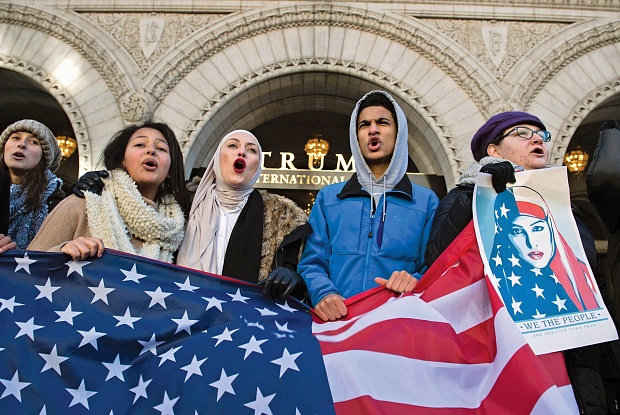
Protesters outside the Trump Hotel in Washington, DC, with an American flag and Shepard Fairey-designed poster. Photo: © MOLLY RILEY/AFP/Getty Images. Courtesy of The Art Newspaper
Institutional leaders say such restrictions would have grave consequences on exhibitions, research and the future of cultural exchange
Artists, curators and leaders of top US museums are anxiously awaiting President Trump’s revised executive order on immigration—and they are prepared to vigorously protest against the new administration’s isolationist policies. The latest order, which was being drafted as we went to press and is expected to target the same seven countries with mainly Muslim populations, could have far-reaching effects on exhibitions, research and the future of cultural exchange between the US, the Middle East and Africa.
A reconstituted ban “would be comparable to blocking a major artery”, says Richard Armstrong, the director of the Solomon R. Guggenheim Foundation in New York. “It would completely constrict the flow of information… and have serious consequences on our capacity to be a citizen in the cultural world.”
The revised ban is expected to target the same countries as the first (Iran, Iraq, Syria, Yemen, Somalia, Sudan and Libya). Unlike the first version, which the White House announced at the end of January, green card holders, dual citizens and travellers who already have a visa are unlikely to be affected.
Cultural leaders say such restrictions would have grave consequences. “If it continues, the travel ban will extract a high human cost in lost freedoms, livelihoods, and careers, as well as a high social cost in lost innovation and discovery,” James Cuno, the president of the J. Paul Getty Trust in Los Angeles, said in a statement last month. The ban might also have a “profoundly adverse effect” on the Getty’s work to protect cultural heritage in the Middle East.
Curators fear that the executive order would make it more difficult to secure loans from the affected countries, because couriers who would ordinarily accompany the works will be unable to secure visas. Linda Komaroff, the curator of Islamic art at the Los Angeles County Museum of Art, who is organising a major exhibition of Iranian art next year, cancelled a trip to Iran after the country placed a reciprocal ban on visas to Americans last month. A revised ban “could make partnerships that we’ve spent years building up very difficult to maintain”, she says.
Artists and scholars are stuck in a state of anxious limbo as they await the new order. In a statement, Thomas Campbell, the director of the Metropolitan Museum of Art in New York, described the impact on three Iraqi fellows in the museum’s department of Ancient Near Eastern Art. “One is now unable to leave the country to see his family, fearing he would not be allowed to return, and the others will no longer be able to participate, given the present uncertainty,” he said.
The ban also poses overwhelming new challenges to cultural heritage experts. “It’s not clear that we can act in the same kind of humanitarian space that we’ve been acting in,” says Brian Daniels, who leads the Safeguarding Heritage of Syria and Iraq Project (Shosi), a consortium that offers financial support and training to cultural heritage experts on the ground in conflict zones. Daniels says that he will likely be forced to move most of the initiative’s activities, including training sessions, outside the US. (A meeting of international experts planned for May has already been relocated to Germany.)
Other Shosi initiatives are likely to be called off entirely, including plans to bring Syrian colleagues to the US for a yearlong intensive training in emergency response. “I don’t know how that is possible now,” Daniels says. Meanwhile, he has been unable to allay the fears of Syrian and Iraqi experts who work with Shosi in the US and have applications for asylum pending. “We may be in a position where we have to transfer our colleagues out of the country for their own safety,” Daniels says. “That is not how I anticipated this project winding up.”
The cultural community was quick to voice its opposition to the initial ban, which was swiftly blocked by US courts. More than 2,300 arts professionals—including the gallerist Marian Goodman, the curator Massimiliano Gioni and the artists Richard Serra and Kara Walker—signed an open letter opposing the order. “The ban affects all of us,” the letter said.
Some museums registered their dismay on the walls of their own galleries. Days after the ban was signed, curators at the Museum of Modern Art (MoMA) in New York sprung into action, rapidly reinstalling the fifth-floor galleries with works by artists from the affected countries. Paintings by Picasso, Matisse and Picabia were replaced with examples by Zaha Hadid, who was born in Baghdad, the Sudanese painter Ibrahim el-Salahi and the Los Angeles-based, Iranian-born artist Tala Madani, among others.
The additions were meant as a “gesture of inclusion” to demonstrate the history of cross-cultural influence in Modern and contemporary art, says the MoMA curator Jodi Hauptman. “If there were no opportunities for travel or communication, we wouldn’t have these things,” she says.
Meanwhile, the Davis Museum at Wellesley College in Massachusetts temporarily de-installed or covered works that were created or donated by immigrants. Around 120 objects, or one-fifth of the works on display, were removed or obscured for six days, until 21 February.
Ultimately, the public will lose out as a result of the administration’s isolationist policies, says Jaime-Faye Bean, the director of ArteEast, a non-profit that supports US residency programmes for artists from the Middle East. “These artists will gravitate elsewhere—to Europe or some of the vibrant art scenes around the globe,” she says. “The administration has sent a chilling message about the role of free and critical exchange of ideas.”